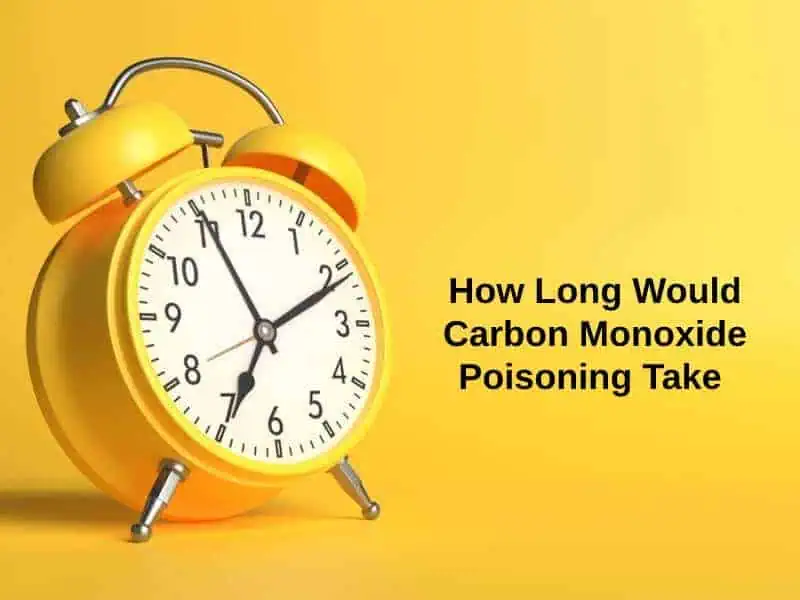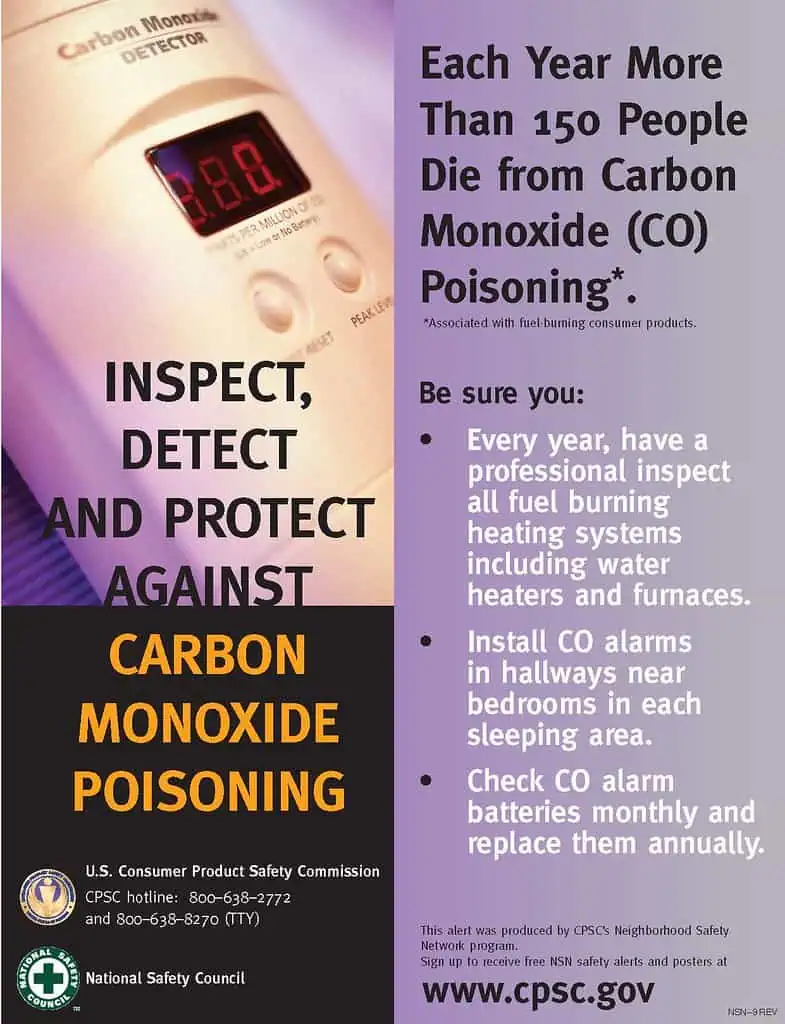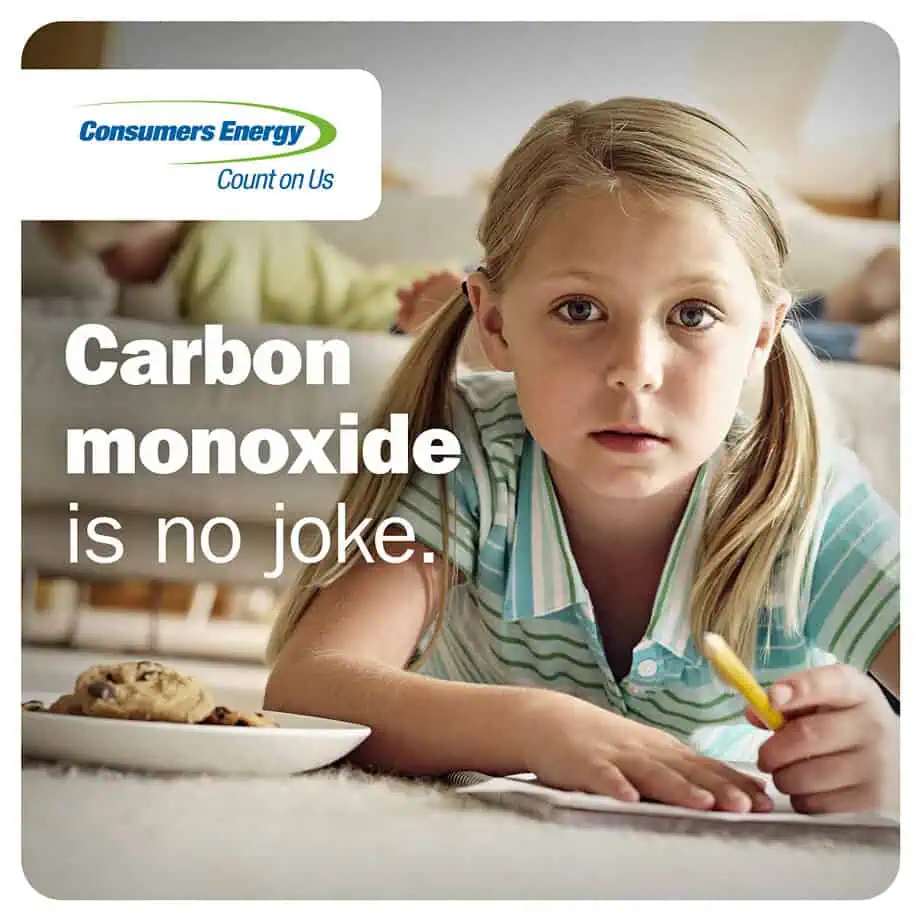Exact Answer: 2 hours
This depends on the concentration of carbon monoxide in the air, so does your age, gender, and general health. According to The EPA also known as Environmental Protection Agency and, The NAAQS also called National Ambient Air Quality Standard, for carbon monoxide is 9 parts per million for over 8 hours, the threshold must not exceed more than once a year.
If the air has a much higher concentration of carbon monoxide, signs of poisoning may occur within 1 to 2 hours. An exposed individual can even be killed under a very high concentration of carbon monoxide in just 5 minutes.

How Long Would Carbon Monoxide Poisoning Take?
| Concentration of CO | Time |
| High | 1 hour |
| Low | 2 hours |
Carbon monoxide poisoning is a potentially fatal illness that happens when carbon monoxide gas increases up in the blood. When someone inhales carbon monoxide, it replaces oxygen attached to the pigment hemoglobin in the blood.
Hemoglobin is the part of the red blood cells that carry oxygen around our body to form carboxyhemoglobin. It hampers the delivery of oxygen to various tissues in the body, which leads to serious damage and even death. Carbon monoxide poisoning is a leading cause of death in different places in the world, killing thousands every year and affecting people in their sleep.
Carbon monoxide is a colorless, odorless, and tasteless gas formed from burning fuel, such as propane, gasoline, coal, and wood, and it builds up in ill-ventilated places. Other Sources of carbon monoxide gas include automobile engines, charcoal grills, indoor heating systems, water heaters, that use gas, and gas stoves. The exposure to carbon monoxide gas from portable devices can be higher in mobile homes, caravans, and, boats.

Other causes of carbon monoxide poisoning include:
- Faulty or blocked car exhausts: leaks or blockage within the pipe, like after heavy snowfall.
- Blocked flues and chimneys: this will stop carbon monoxide gas from escaping, allowing it to succeed in dangerous levels.
- Burning fuel indoors or in unventilated spaces: again it will not allow the carbon monoxide gas to escape.
- Paint fumes: some cleaning fluids and paint removers (contains dichloromethane). It is a substance that is reduced to carbon monoxide gas by the body.
Why Would Carbon Monoxide Poisoning Take That Long?
It might take 5 minutes to 2 hours to carbon monoxide poisoning. But it is difficult to detect because carbon monoxide symptoms imitate the flu: confusion, lethargy, nausea, dizziness, headaches, and irritability. Continued exposure can lead to vomiting, unconsciousness, heart irregularity, brain damage, breathing difficulties, muscle weakness, abortions, and possibly death.
Because the symptoms impersonate so many illnesses, so sometimes there is misdiagnosis. In winter, the doctor might have a suspicion of carbon monoxide poisoning in patients who complain about feeling nauseous or have severe headaches. Also, it is very true if other family members or colleagues and co-workers have the same symptoms in the house might get sick.

If the doctor suspects carbon monoxide poisoning, the patient will have to get a blood test that will measure the concentration of carbon monoxide in their blood. One might have additional blood tests to check their overall shape and to look for other issues affected by it.
When a person inhales carbon monoxide, it chemically bonds with hemoglobin, displacing oxygen and forming carboxyhemoglobin (COHb) and results in a lack of oxygen to the body tissues and cells. The affinity of CO and hemoglobin is around 250 times higher than the attraction between oxygen and hemoglobin. The brain and heart require large amounts of oxygen and instantly suffer if there is any oxygen deficiency.
Conclusion
To prevent ourselves from carbon monoxide poisoning, one must follow some precautions. First, purchase a carbon monoxide detector. Second, have all heating appliances checked per annum by a professional heating contractor. And third, substituting heating units with direct-vent sealed-combustion units.
If someone suffers from CO poisoning, one should immediately be transferred somewhere with the fresh air along with medical professionals assigned. The treatment will depend on the amount of carbon monoxide present in the bloodstream of the patient, along with the evaluation of their vitals.
In critical cases, the doctor keeps the patient in a hyperbaric chamber or a pressurized oxygen chamber for treatment and oxygen administration. The combination of oxygen and elevated pressure quickly forces carbon monoxide gas from the body.